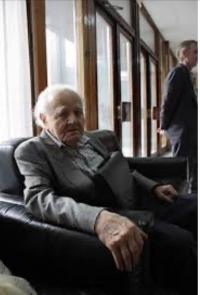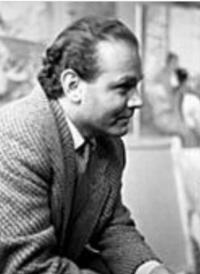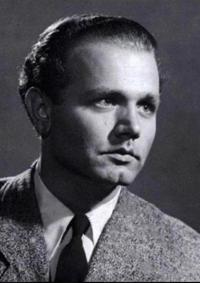My teachers: Leonid Timofeevich Zhdanov
It was difficult for me to begin writing about this teacher. I proudly say: I am a Zhdanov graduate. When I meet colleagues who also graduated from Leonid Timofeevich’s class, we often joke about how, during conversations, he would pinch the back of your neck—not just a pinch, but a firm grip that he wouldn't release for quite some time. We remember his jokes, his stories. We remember our teacher.
"It's very simple, boys," he would say, and then proceed to demonstrate a rather complex combination of movements. Did he yell? Yes, he did; he could get angry from time to time. But I remember something else.
Leonid Timofeevich took our class in our final graduating year. Our class had gone through a lot of teacher changes. That’s just how "lucky" we were. And so, in our final year, we were entrusted to Leonid Timofeevich Zhdanov, who had just returned after several years of teaching in Warsaw, Poland.
Previously a leading dancer at the Bolshoi Theatre during one of the brightest periods in the development of Soviet ballet, he was a witness to and participant in many brilliant premieres, knew fascinating people and worked with them, and was friends with many notable theater masters and legends. He often told us about the people he worked with, about rehearsals, productions, and the theater. All of this was very important for our upbringing, our development as artists.
It was a significant graduation year, as three different classes were completing their studies. I don’t know if there were any other such large-scale graduations at the Moscow academy: three classes of young men were graduating under three leading teachers—Pyotr Antonovich Pestov, Alexander Alexandrovich Prokofiev, and Leonid Timofeevich Zhdanov. I don’t think there was any competition among the teachers, although a competitive spirit is always present. But among us boys, it certainly was. The frequent changes of teachers in our class did not bring positive results. We were lagging behind in technical development. Perhaps for this reason (with only one academic year left before graduation), or rather due to his pedagogical style, Leonid Timofeevich did not chase after technique, instead paying much attention to the purity of execution, style, and musicality. Only classical music was played during the lessons. When assigning combinations, he trained us not only to perform technical elements cleanly but also to pay attention to the connecting movements and dance transitions. The combinations were stylistically different, depending on the music—Mozart, Tchaikovsky, Scriabin—each sounded differently not only in the pianist's performance but also in the combination of movements and poses of our teacher. It was challenging. We wanted to learn "tricks," but we were given beautiful dance combinations.
Leonid Timofeevich also taught Partnering in our class. A former premier of the Bolshoi Theatre, a partner of great ballerinas like Galina Ulanova, Maya Plisetskaya, and Raisa Struchkova, he was brilliantly skilled in the duet technique. While demonstrating, he would often support the girl with one hand and, without stopping the dance combination, use the other hand to explain the correct execution. And again, the focus was on execution of the movements, the positions of the hips, torso, and arms. The aesthetics of the poses, elegance, and dance quality. "The partner is always at fault," he would say. "Even if the girl is wrong, you are the man. Don’t argue. Try it again." Perhaps this wasn’t entirely right, but it taught us young men to be attentive to our partners. Arguments were not allowed. He carefully explained the mistake, could check the failed element with the girl himself, and, after correcting her, asked us to repeat it: "It’s important to understand the mistake yourself; simply repeating it mindlessly won’t yield any results."
That was a very interesting year. A year of interacting with a warm, art-loving, intelligent person. Demanding precision in classical dance, preserving the beauty of this art’s poses, and maintaining elegance. He would get angry, shout, joke, and sometimes touch a nerve. Having just returned from Poland, he would jokingly use Polish words. "Żelazko," he would shout at a poorly stretched foot. In Polish, this means an iron. He often told us about his life, about walks in the park with his son, and about photography.
Photography was one of the main passions of his life. On the second floor of the academy building, all the walls were adorned with his ballet photographs. Stars of the Bolshoi Theatre, captured in magnificent poses and jumps, moments of rehearsals, and performances. These were highly artistic photographs that immortalized an entire generation of ballet stars. One wall was dedicated to Kasian Goleizovsky, featuring photographs of the great choreographer himself and his rehearsals with Ekaterina Maximova in a mazurka. Leonid Timofeevich loved to tell us about his friend, the choreographer Kasian Goleizovsky, about his style, artistic principles in work, and about the importance of imagery.
It’s probably difficult to engage 17-18-year-olds, who are dreaming of double cabrioles, with conversations about images and symbolism in ballet, but step by step, we began to understand and listen to our teacher. Did everyone? Always? This was the greatest challenge in our communication. It seemed to keep us at a distance from our teacher. We dreamed of double cabrioles, double tours... Leonid Timofeevich believed that the main goal in school was to teach the correct execution of movements, without chasing after technique at this stage. "A double cabriole is not a difficult movement," he would tell us. "But only if you execute a single one correctly. If your torso, hips, and arms are in the correct position, one fine day you’ll feel ready and perform the double." Again and again, he wouldn’t allow us to try the double, closely monitoring the correct execution of everything: from the approach to the position in the jump and the landing from the jump. "The Moscow school," he would exclaim, jumping up from his chair. "Finish double tours precisely towards the audience, plié, hold your back, arms exactly in the second position. Precisely towards the audience and hold the pose. These are the Moscow tours!"
And we tried—tried to do the Moscow tours. He taught us to pay attention to style, aesthetics, and nuances born in movement.
At some point, Leonid Timofeevich and I somehow grew closer. At that time, like many young men of that age, I wrote a bit of poetry. Leonid Timofeevich was one of the few who read them. He never praised or criticized them. But he very accurately noted the imagery that he liked and would talk about it. Since I was no poet, this quickly ended, but some of the poems remained. When I find them in my archives today and reread the lines that caught Leonid Timofeevich’s attention, I am always surprised at how carefully he treated these awkward thoughts of a young man and noticed in them something valuable, which I myself hadn’t realized at the time.
One day, Leonid Timofeevich came to class with a maple leaf in his hand. He had found it on his way to the school. The beauty of this leaf struck him, and he began the lesson by talking about the beauty of the nature around us. We stood in first position, waiting for the command “reverence,” with which a ballet lesson begins, and listened about the maple leaf.
That was our unusual teacher. His hair always slightly tousled on the sides of his head, and a hurried look that would suddenly stop on you and begin to study you deeply. His gaze softened—that meant the conversation was coming to an end. But there wasn’t a trace of malice in this—there was a kind of bewildered warmth.
Our graduation passed. We said goodbye to the academy and scattered across the country, then the vast Soviet Union. At the graduation party in the restaurant, towards the end of the evening, I found myself squeezed between Sofia Nikolaevna Golovkina, the renowned head of the academy, and Leonid Timofeevich at the teachers’ table. He looked at me with a certain elusive bitterness in his eyes and began to apologize for not being able to teach me everything he could have, better, achieving more.
Having stayed in Moscow, in my first year working at the Bolshoi, I went back to the school a few times to take a class which he was teaching at the time. It wasn’t a desire to show off in front of the younger students—rather a desire to test myself. In the theater, classwork was no longer under such strict control of a teacher. I noticed his satisfied look: “Your feet have strengthened… you’re watching your hips correctly,” “You need to be more attentive to the positions of your arms.” He was very touched by my desire to continue my professional growth and development. But, unlike some other teachers, he wasn’t following the achievements of his former students in the theater. Maybe it only seemed that way; maybe he was aware but didn’t want to hold onto the young artists who had stepped out into the world. I don’t know. He regularly attended the theater with his camera—it was his passion. “I photograph the most beautiful things—ballet and horses,” he would joke. At first glance, a very strange combination, but if you think about it… His photographs always had a sense of flight. The flight of thought, of beauty.
In recent years, he often complained that the younger generation had changed so much—the beauty and style in ballet were getting lost, and teaching had become much more difficult. Once, while we were sitting together in a box at the Bolshoi Theatre during a concert, after the performance of the Pas de deux from “The Nutcracker” in Vasily Vainonen’s choreography, he leaned over to me and said with great bitterness: “You know, Kostya, all that Vainonen pointed out as mistakes and corrected in me during rehearsals, they dance today.” He was very upset.
We used to meet frequently at times and with long gaps at others, but every time he saw me, the conversation began as if we had parted just a few hours ago. I remained his student, and he remained my teacher—just as he was, just as I remember him.
I am a Zhdanov graduate!


